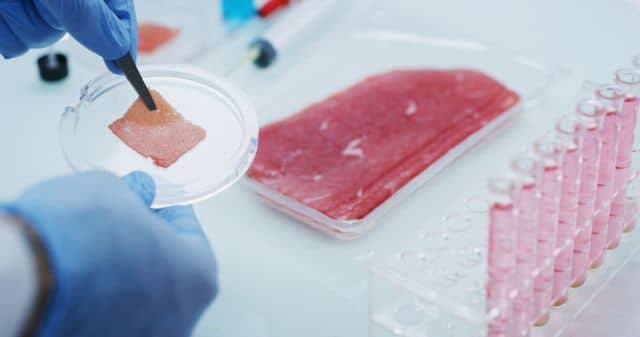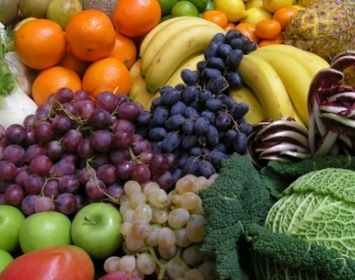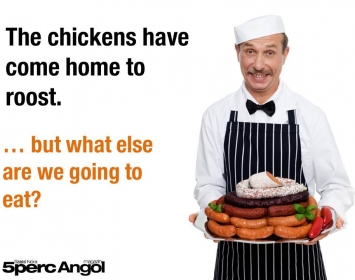A new way of eating: artificial meat
by Kitti Bába

How did we end up growing meats inside laboratories instead of farms? Besides the fact that artificial meat is more environmentally friendly, it takes up to ninety percent fewer resources to grow meat in a tube than to raise a real animal outdoors on a farm. These meats are also called “healthy meat”, “slaughter-free meat”, “cell-based meat” or “synthetic meat”. Let’s find out what is so special about this new way of meat-producing.
The history of artificial meat
The idea of artificial meat is fairly old. It was first mentioned by Winston Churchill in 1931. He said that there needs to be a better way to consume meat, instead of growing a whole chicken and eating only the breast and wings. However, the first research about cell-based meat only appeared in 1981 when Russell Ross started to grow cells inside a tube. After 8 weeks he could grow a muscle of a guinea pig’s aorta. Later in the early 21st century a Dutch dermatologist, Wiete Westerhof, and two of his partners announced that they will try a way to produce artificial meat. In the process they seeded some collagens with muscle cells, then this mixture was bathed in a nutritious solution.
We can tell by now that these early experiments were not successful. Despite the fact that these processes were advertised as alternatives to real meat, people did not like the taste of these products. People reported that these meats tasted “nothing like real meats”.
Not much changed until the 2010s when new methods have been tried. Companies started using artificial intelligence to detect compounds of meats then replace these with vegetables that share the same molecules. Also, there was a great mystery why meat tasted so good. Researchers have found out that it is because of a special iron type that can only be found in meat. They have successfully created this special iron artificially and added it to the recipe that made some great alternatives for people who didn’t want to eat slaughtered, real animals.
Is artificial meat good for me?
People tend to be afraid of things that start with artificial, synthetic, or anything that screams not natural. Companies like to label their food with “not genetically modified” to make it more appealing. Such companies, however, have to modify crops to grow faster and serve the demand, or to adapt to the environment they had been planted into. Besides the general opinion about these products, they are not harmful in any way to humans. Many people are also concerned about the taste of these new types of meats. Thanks to modern technology, the so-called “veggie meats” taste just like real meat, but they won’t have a high cholesterol, or high sodium content because of the way they are made.
How will artificial meat benefit the environment?
We can imagine how much water, food, and space is required for having cows that could serve the world’s meat-eater community. We would, however, only need ten percent of it to produce the same amount of synthetic meat. The problem most of the time is how much money it costs. The first cell-based meat cost almost half a million US dollars, but they could decrease the price to somewhere around a couple of hundreds of dollars. This price is still very expensive for low-income families. They could not afford to switch to it right away, just because it is better for the environment.
What is the future of meat?
If we want to keep up with the increasing population and save our planet, we have to change our habits when it comes to consuming food. We have to break down the stereotypes about genetically modified food or artificially grown meats. First of all, we have to serve nature not the other way around. If it tastes like meat, if it feels like meat, if it is just as healthy as meat, why wouldn’t we change to it? The biggest issue surrounding synthetic meat, however, is that it is a new concept and not yet socially accepted. We can assume that artificial meat will first become popular is high-class societies – because of its very high price – and later can be consumed by middle-class households as well. Until then, we need to find ways of protecting the environment and look after our consumer habits.
A cikk elolvasása után válaszolj a következő kérdésekre a szövegben olvasott információk alapján.
- Why is Winston Churchill important in the history of artificial meat?
- What was Russell Ross able to produce?
- What did people who tasted the first experiments of artificial
meat say about “synthetic meat”? - What makes meat taste so good?
- What are the advantages of “veggie meats”?
- What is the greatest disadvantage of “veggie meats”?.
- What do we have to change first?
keys/megoldások: 1. It was him who first mentioned the idea that there needed to be a better way to consume meat.; 2. He started to grow cells inside a tube and after 8 weeks, he could grow a muscle of a guinea pig’s aorta.; 3. People reported that these meats tasted “nothing like real meats”; 4. The special iron type that can only be found in meat.; 5. They taste just like real meat, but they won’t have a high cholesterol, or high sodium content because of the way they are made. They are better for the environment.; 6. Low-income families could not afford to switch to it right away.; 7. Our way of thinking that we have to serve nature not the other way around.
Vocabulary
| laboratory | laboratórium |
| environmentally friendly | környezetbarát |
| tube | kémcső |
| synthetic | szintetikus, mű |
| to consume | fogyasztani |
| cell | sejt |
| aorta | főütőér |
| collagen | kollagén |
| nutritious solution | tápoldat |
| experiment | kísérlet |
| compound | vegyület |
| iron | vas |
| genetically modified | génmódosított |
| appealing | vonzó |
| harmful | káros |
| to be concerned | aggódni |
| sodium content | nátrium tartalom |
| community | közösség |
| low-income | alacsony jövedelmű |
| increasing | növekvő |
| stereotype | sztereotípia |
| issue | probléma |
| middle-class | középosztály |
| household | háztartás |







